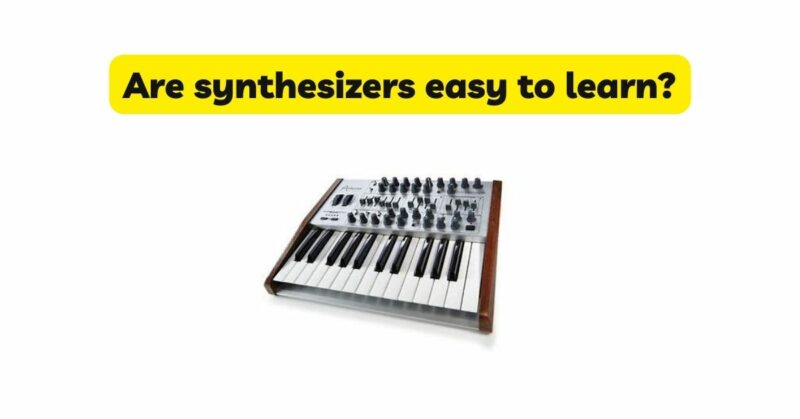Synthesizers have long captivated musicians and enthusiasts with their boundless sonic possibilities and the ability to create unique and innovative sounds. However, one common question that arises is whether synthesizers are easy to learn. In this article, we will delve into the world of synthesizers and examine the factors that influence their learning curve. By gaining a deeper understanding of the challenges and rewards associated with learning synthesizers, aspiring musicians can make an informed decision about embarking on this exciting musical journey.
I. The Nature of Synthesizers: Before diving into the learning curve of synthesizers, it is important to grasp the fundamental nature of these instruments. Synthesizers are electronic musical instruments that generate sound through various synthesis techniques and electronic signal processing. Key elements of synthesizers include:
- Sound Generation: Synthesizers employ oscillators to generate sound waves of different shapes and frequencies. These oscillators can be combined, modulated, and shaped using various synthesis techniques, resulting in a wide range of sounds.
- Sound Manipulation: Synthesizers offer extensive control over sound parameters such as filters, envelopes, modulation sources, and effects. This flexibility allows musicians to shape and sculpt their sounds to create unique timbres and textures.
- Programmability: Modern synthesizers often feature programmability, enabling users to store and recall custom patches or presets. This allows musicians to create and save their own unique sounds or access a library of sounds created by others.
II. Factors Influencing the Learning Curve: Several factors contribute to the learning curve of synthesizers. Understanding these factors can help aspiring musicians gauge the level of effort and time required to become proficient in playing and programming synthesizers.
- Sound Design Fundamentals: Learning synthesizers involves gaining a solid understanding of sound design principles. This includes grasping concepts such as oscillators, filters, envelopes, modulation, and effects. Acquiring this knowledge is essential for creating and manipulating sounds effectively.
- Programming Interface: Synthesizers often feature complex programming interfaces, including menus, parameters, and controls that can seem overwhelming to beginners. Learning to navigate and understand these interfaces takes time and practice.
- Signal Flow and Patching: Understanding the signal flow within a synthesizer and how different modules connect and interact is crucial. This knowledge helps musicians route and process sound effectively, enabling them to achieve desired sonic results.
- Technical Knowledge: Synthesizers incorporate various technical concepts, including waveform types, frequency modulation, and signal routing. Acquiring a basic understanding of these technical aspects can enhance one’s ability to use synthesizers creatively.
- Musical Background: A musician’s prior musical experience and theoretical knowledge can influence the learning curve of synthesizers. Familiarity with concepts such as scales, chords, and music theory can expedite the process of creating musical compositions using synthesizers.
III. Learning Resources and Support: The availability of learning resources and support greatly affects the ease of learning synthesizers. Fortunately, there are numerous educational materials and communities that can assist in the learning process:
- Online Tutorials and Courses: The internet offers a wealth of synthesizer tutorials, videos, and online courses. These resources cover topics ranging from basic synthesis principles to advanced sound design techniques, providing a structured learning path for beginners and experienced users alike.
- User Manuals and Documentation: Synthesizers often come with comprehensive user manuals that explain the instrument’s features, programming options, and functionalities. Reading and referring to these manuals can be highly beneficial in understanding the instrument’s capabilities and operation.
- Community and Forums: Joining online communities and forums dedicated to synthesizers can provide invaluable support and guidance. Engaging with fellow synthesizer enthusiasts allows for the sharing of knowledge, troubleshooting, and inspiration.
IV. Patience, Practice, and Experimentation: Learning any musical instrument requires patience, practice, and a willingness to experiment. These principles hold true for synthesizers as well. The following tips can aid in the learning process:
- Start Simple: Begin with the basics of synthesis and gradually build upon your knowledge. Starting with simple sounds and gradually exploring more complex techniques allows for a more manageable learning curve.
- Hands-On Approach: Actively engaging with the synthesizer, experimenting with different parameters, and exploring the various sound-shaping possibilities will deepen your understanding and enhance your creativity.
- Practice Regularly: Consistency is key when learning synthesizers. Regular practice sessions dedicated to exploring different sounds, recreating existing sounds, and experimenting with new ideas will contribute to skill development and familiarity with the instrument.
- Learn by Replicating: Recreating sounds from your favorite songs or artists can be an effective way to develop synthesis skills. Analyzing and deconstructing sounds will help you understand the techniques and settings used to achieve specific results.
V. Conclusion: Learning synthesizers is a rewarding journey that offers musicians endless creative possibilities. While synthesizers may initially seem complex, with their diverse programming interfaces and sound design concepts, they are ultimately learnable instruments. The learning curve of synthesizers can be influenced by factors such as sound design fundamentals, programming interfaces, technical knowledge, musical background, and the availability of learning resources and support.
By embracing a patient and exploratory mindset, utilizing educational resources, seeking community support, and dedicating regular practice sessions, aspiring musicians can navigate the learning curve of synthesizers and embark on a fulfilling musical adventure. Remember, the journey of learning a synthesizer is as much about the process as it is about the destination, with each step offering new opportunities for growth, creativity, and sonic exploration.


